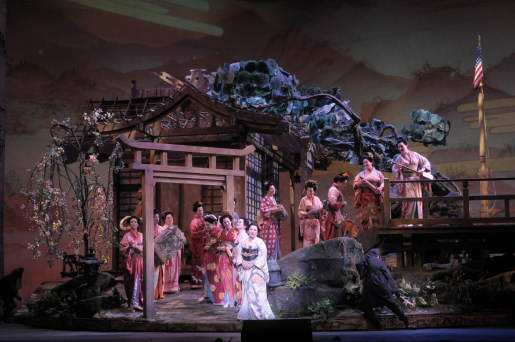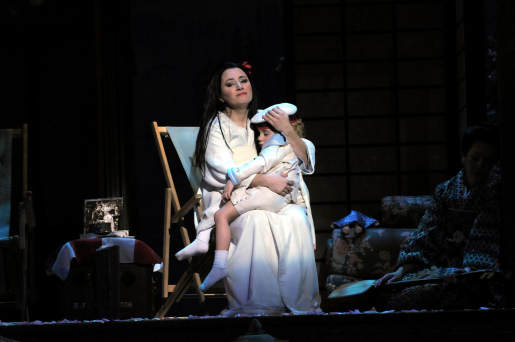Other Links
Editorial Board
-
Editor - Bill Kenny
Founder - Len Mullenger
Google Site Search
SEEN
AND HEARD INTERNATIONAL OPERA REVIEW
Puccini, Madama Butterfly: Soloists, Chorus and Orchestra of Lyric Opera of Chicago, Sir Andrew Davis (conductor) Civic Opera House, Chicago 20.12.2008 (JLZ).
Among all the recent celebrations of the 150th anniversary of the
birth of Giacomo Puccini, this single production of Madama
Butterfly by Lyric Opera of Chicago in its 2008-2009 season may
seem modest, but it is an intense and effective staging of the opera
that pays tribute to the long-standing Puccini tradition in this
house. Dating from the early 1990s, the production, originally by
Hal Prince, remains engaging for its successful fusion of elements
from traditional Japanese theater with Puccini’s enduring tragedy.
In the century since its premiere in 1904 at La Scala, Madama
Butterfly has been staged in all all manner of presentations,
and the present one, familiar to Chicago audiences for about 15
years, remains impressive. Like all good opera, the staging is
solidly musical and theatrical, and the present production benefits
from an extremely fine cast and delivery.
Frank Lopardo was an equally fine Pinkerton. As with Patricia
Racette, the required range is well within his voice, and he made
the part sound as natural as if he were speaking it. His
interaction with the Bonze was particularly effective for its almost
heartfelt warning off of the nay-saying uncle, and he emphasied this
decisive moment through the intensity of his singing. Afterwards,
the duet with Cio-Cio-San made perfect sense as a return to calm in
their fragile, short-lived intimacy. With “Addio, fiorito asil,” in
the third act, he revealed his true sentiments forcefully as he
essentially closed the door on any prospect of keeping in contact
with his Japanese wife. If Mr Lopardo’s intrepretation underscored
all aspects of Pinkerton’s self-centered personality, his
performance at the end of the opera gave a sense of the shock and
regret his character perceives when he finds that his Butterfly had
just taken her own life. As much as this music is familiar, this
point was particularly moving, emphasised by the Kabuki
stage-gestures that Hal Prince uses in this production, in which the
black-robed and veiled stage hands pull a red cloth from
Cio-Cio-San’s costume to indicate her demise.
Production:
Original Production: Harold Prince
Director: Vincent Liotta
Set Design: Clarke Dunham
Lighting: Christine Binder
Conductor: Sir Andrew David
Chorus Master Donald Nally
Cast:
Lt. B. F. Pinkerton: Frank Lopardo
Goro: David Cangelosi
Suzuki: Katharine Goeldner
Sharpless: James Westman
Cio-Cio-San (Madama Butterfly): Patricia Racette
The Imperial Commissioner: Craig Irvin
The Official Registrar: Daniel Billings
The Bonze: Paul Corona
Prince Yamadori: Coery Crider
Kate Pinkerton: Amber Wagner

The Act I Set
Patricia Racette, familiar to audiences around in the US and Europe,
for her command of a wide variety of roles, gave a compelling
portrayal of the title character with fine singing and excellent
acting. As Liu in Lyric’s production of Turandot in the
2006-2007 season, Racette demonstrated to Chicago audiences her
affinity for Puccini’s music, and this production of Madama
Butterfly revealed her mastery of it. Ms Racette approached the
music as if it were composed for her, since her voice is exactly
within the required range for the role. She was able to convey the
youthfulness needed in the first act while, conveying all the strong
emotions of the scorned first wife when the drama culminates at
Pinkerton’s return.
This evenness of vocal ability also allowed Ms Racette to produce
all of the colours required for a subtle characterization. This was
most evident in her masterful performance of the familiar second-act
aria “Un bel dì vedremo,” since she sang the passages that lead up
to the piece with increasingly longer sustained phrases. By doing
this, Ms Racette held firm to the composer’s intentions, fully
honoring the conventions of Verismo opera in which lyricism
is allowed only when it when it fits the drama exactly, rather than
being constrained by the earlier operatic structures of recitative
and aria, a convention which belongs to another style.
Yet the dramatic aspects of this role are essential to its
successful execution, and Puccini deliberately built into the work
some elements that assist. For one, Cio-Cio-San makes it clear that
she is an American wife in the first act, which, allows her
to behave outside of her nominally Japanese character. Ms Racette
used this as an opportunity to make the most of the places in the
opera that demonstrate cultural differences and her wholehearted
involvement in the role was evident in her acting, her eye contact,
physical gestures, and demeanor. More than that, near the end, when
Cio-Cio-San becomes resolved about her fate, and Japanese honor
trumps American naturalization, she bows pronouncedly to Suzuki, and
this underscores her decision eloquently. At that point Ms Racette
noticeably sang with minimal vibrato, accentuating the music which
Puccini makes more overtly pentatonic as he draws the work to its
tragic conclusion. All in all., Ms Racette gave a festival-quality
performance in this production.

Patricia Racette as Cio-Cio-San
This particular gesture was just one of the elements of the
production that make it effective. Without other kinds of gratuitous
Orientalism brought into an otherwise Eurocentric production, the
three-dimensional, revolving stage turned by the stage hands gives a
sense of immediacy to the opera. At the core of the set is the home
that Pinkerton sets up for his life with Cio-Cio-San, and it
occupies the stage neatly, with a porch, steps, and prominent
American flag. The rooms are functional enough, and work well to
demonstrate the modular walls which emerge in the conversation
between Pinkerton and Goro early in the first act. Mounted on a
rotor in the center of the stage, this style of set also facilitates
the changes of scene by foregoing the closing and opening of a
traditional curtain when the set shifts. Other elements, among them
the model of a ship taken across the stage by an actor, is a
relatively simple gesture that fits well into a production which
succeeds in achieving the sometimes difficult fusion of elements
from different and antagonistic cultures; essentially, it is a
visual presentation of what Puccini put into his score.
The baritone James Westman was a sympathetic Sharpless, whose
acting suggested a knowledgeable consul, wary of the dangers of
treating Cio-Cio-San as merely ‘a Japanese wife’ , the designation
that sets the tragedy into motion. Mr Westman interacted
empathically with both Lopardo and Racette, and was particularly
moving in the third-act trio “Io so che alle sue pene” with
Pinkerton and Suzuki, his clear sound and articulation enhancing
his performance. Similarly, Katharine Goeldner was also moving as
Suzuki, whose acting matched her fine singing. The remainder of the
cast was appropriately suited to the production, with the tenor
David Cangelosi, a regular member of Lyric Opera, bringing some
humanity to the character of the manipulator Goro.
Supporting all of this was the fine conducting of Sir Andrew Davis.
He breathed a freshness and lyricism into the score of this
perennial opera, with tempi that fit well into the efficient
production. More than merely accompanying the singing, Sir Andrew
brought out all of the orchestral passages supporting the stage
action, making clear the references to American culture, like the
quotations of the US national anthem. His intensity complemented the
performers on stage, and it is difficult to imagine the intense
scene between Pinkerton and the Bonze, without the equally intense
orchestral accompaniment or the commensurate delicacy in the
intimate scene that follows it. His mastery of this score clearly
helped bring out the best of the performers on stage.
With all that this production of Madama Butterfly offers, it
is worth seeing to catch some of the touches unique to this staging.
Those unable to attend the remaining performances may hear them in
the Lyric broadcasts that are in syndication at the end of the
season. It is unfortunate that no video exists yet of this
production, but a film of Hal Prince’s staging with an earlier cast
has been seen on public television in the United States (with Anna
Tonowa-Sintow and Richard Leech).This is a laudable production which
is yet another of Lyric Opera’s recent fine contributions to modern
opera stagings, which is all the more laudable for being reprised
with an excellent cast, especially with Patricia Racette as Madama
Butterfly.
James L Zychowicz
Photos ©
Dan Rest
